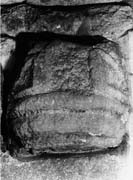Select a site alphabetically from the choices shown in the box below. Alternatively, browse sculptural examples using the Forward/Back buttons.
Chapters for this volume, along with copies of original in-text images, are available here.
Object type: Two fragments of hogback [1]
Measurements:
a: H. 31.5 cm (12.4 in); W. 23 cm (9 in); D. Built in;
b: H. 34 cm (13.4 in); W. 31 cm (12.25 in); D. Built in.
Stone type: Medium-grained, brownish-yellow (10YR 6/6) sandstone; see no. 1.
Plate numbers in printed volume: 438-439, 441
Corpus volume reference: Vol 3 p. 129-130
(There may be more views or larger images available for this item. Click on the thumbnail image to view.)
Only the heads of the end beasts survive. Both are identical in design: masks which lay on the top of the monument, which must therefore have been of type e, the dragonesque variety. They have a shallow, rounded section. The jowl is a broad bill with a slit for a mouth. A modelled, raised band serves as a muzzle, behind which similar mouldings form quadrant-shaped eyes.
The distribution of this type of hogback is an easterly one, Lythe, North Riding, being the chief centre. The convex roof and broad bill-like jowls, are reminiscent of Barmston 1 (Ills. 423, 426). The treatment of the eyes is unique though the Barmston beast provides the nearest echo.



